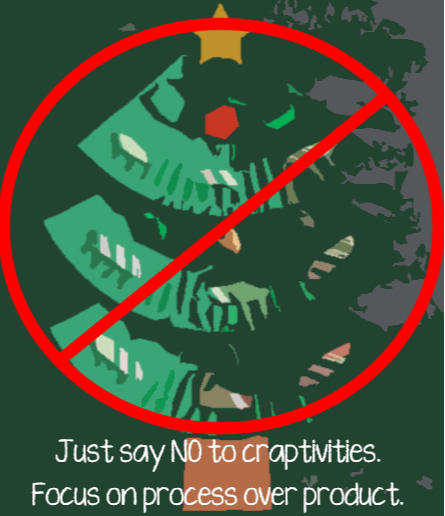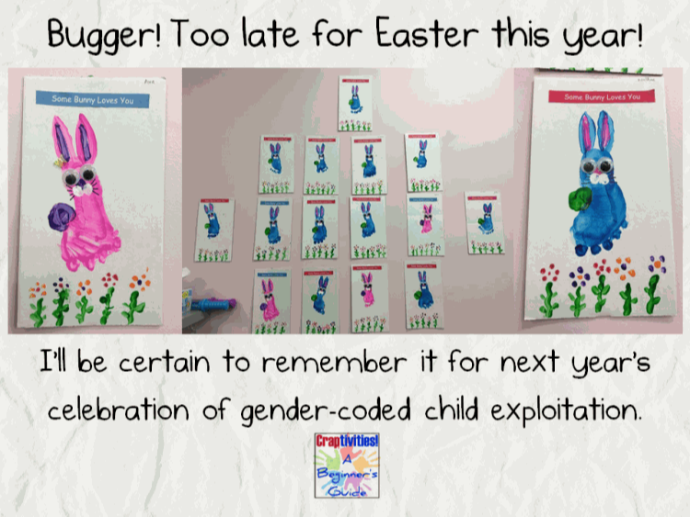Creative craft activity or craptivity?
It's all in the delivery. You decide.
‘Craptivity’ memes and subsequent support of this term, has recently besieged educator forums. An audience was divided last Christmas with a meme that resembled something like this paper plate Christmas tree. More recently, we’ve seen similar memetic creations mirroring current online arguments every time an educator shares examples of the adult led craft. It happens time and again, Christmas, New years, Valentines Day, St. Patrick's Day, Easter... it goes on. Year round, the argument recycles with a different flavour. This one is the latest...


Crapitvites, referring to crappy craft activities – points the finger at art and craft activities in Early Childhood Education and Care that are product oriented; hand/foot paintings made into ‘art’, paper plate craft, stencil activities. Any craft that looks like it’s been created on a factory line of a dozen children creating the same product is under critically reflective fire. If it involves the painted print of a child's digits, the practice of human stamping is likely to be frowned upon. We can thank Jeanne de Clisson from the EYLF pirates for coining that apt term. If you haven't read her piece, check it out here. Forums are divided every time a new meme circulates with educators expressing things like; “Thank goodness you said what I was thinking!” OR “Stop it, I don’t like it. That’s ‘educator shaming’ and you should get off your high horse and stop being so mean”.
Ideally, educators and early childhood education professionals would benefit from finding a space to critically analyse practice, without it becoming personal. However, clearly, some more thinking needs to happen around how we can share messages of good practice in Education and Care in a way that is going to foster a culture of professional inquiry and produce favourable outcomes for children. We are educators, after all, not babysitters.
Anne Peters posted her thinking about this on the Educators Engaging with Educators Facebook group. The following is a re-post of her thoughts...
So much angst and ill feeling about the posts and dialogue about ‘Craptivities’ has encouraged me to unpack the reasons behind them. As I truly believe that Educators want to do what is best for the children they work with, it is easy to see why many educators were upset and offended by this meme. However, let’s take a look at the reason craft and activities are currently being critiqued in early childhood education. What I provide for you now is my interpretation of what I believe these memes and arguments against these product driven craft activities are trying to convey. In no way is this article meant to belittle your pedagogical practice and efforts. So for the length of this post, I would like all educators to take a step back and openly consider these points with me.
There are two key messages that practitioners (including the authors of these memes) seem united in conveying when they critique templated craft activities:
Age appropriate activities:
It is arguable that these activities are not appropriate for children’s development of age. As these activities are outcome driven (end product), they provide little in terms of process as freedom in creation is limited.
There is a distinct possibility that most children in early childhood may have little or no interest in the end product and would prefer to focus more on the experience. For example, when you hear someone ask a child “What is your drawing about?” often the child struggles to find an answer. It is usually the act of drawing, and not that of drawing ‘something’ in which the child learns and derives pleasure.
The same applies to construction. Very often the joy of the experience lies in doing it. The process. They are not initially focused on making the road, creating a robot, building a castle. They just want to use the materials and see what they can do with them.
This isn’t to say that ‘product’ doesn’t have its place. Product-driven activities could be seen to be more developmentally appropriate
Creativity:
Being ‘end product’ driven leads me to the next point. Do these activities stifle creativity? Utilising a model robs the children of creating their own art.
Furthermore, when a model is provided for children to copy, the subconscious message received is; “this is adult approved”, and therefore better than what they would have produced on their own. We quickly learn in our formative years through a review of peers and adults that some of what we create is “great”, and some of it is “mess”. When we draw a star, cut out a Christmas tree, or choose the “right” colours for the giraffe, the message they may internalise is “I need to make mine look like the adult’s one, as my own will not be good enough.”
My analysis here may result in more questions than answers. But this is a good thing. Questioning our practices helps us become ever progressing Educators.
Some of your questions may include:
“What if the children want to do it?”
If the children want to do it, then that is fantastic. How about we give them all the materials and tools they want and let them do it how they want. This way creativity is fostered.
“The children love it so why should we change it?”
Some do, sure. They also love sugar and screen time. Does that mean we don’t think critically about how much of that we offer children? By reflecting on and evolving our practice, we can provide similar experiences that children love while also nurturing learning and creativity.
“Isn’t there other learning which takes place in these activities?”
It's argued by educators in support of these craft activities, that there is lots of hand-eye coordination, and fine motor skills being developed, etc. But there are many other ways to also provide for these learning outcomes without giving children a craft model to copy. These skills can be developed just as effectively by resourcing your learning space with loads of open-ended materials and loose parts. In fact, young children need to develop their gross motor muscles and skills through play and movement (ideally outdoors) before they are ready to sit and cut out a paper plate.
“What about cultural celebrations?”
Providing children with templates and having them decorate these is one way to involve the children in recognising and participating in cultural awareness and celebration. Some argue, however, that template decorating is not true art, which is creative and is also very limited in what children can learn about the culture. Further reflection here may result in better ways to involve children in cultural learning and celebrations.
“What about the parents?”
Some parents and families may expect craft-type creations from their children – especially at celebration times (Mother’s Day, Christmas). This expectation has likely been developed by previous generations of Educators providing such crafts and is perpetuated by those selling such craft materials. Offering parent’s a piece of individual art created solely by their child, I believe would carry more value than a production line driven generic copy of a model. Furthermore, this does not need to be provided at specific celebration times.
Are we not happy in other situations to explain to a parent when a parent complains about “messy play” or wants you to teach their child “academic subjects”? As long as we address these issues with respect and explain why we do not support such activities, we can get the same message across to families about the value of creative art and exploration through play.
“So what is acceptable?”
Art experiences are those that allow the child to explore their own creativity using materials and tools. This means not just the familiar art materials such as paint or clay, but anything and everything that offers the potential to be creative. There are many excellent resources by many fine art experts. If you want inspiration, please undertake further research.
“Should we teach children anything?”
In my opinion, we can teach children how to successfully manipulate the tools and materials they are using to have the best outcomes for their efforts.
Much of this will be incidental teaching. For instance, “If you wipe some of the glue off your brush, it will stop the paper tearing. The paper is tearing because the glue is making it wet, and wet paper tears.” Or “When you put the paint brush you were using for red in the green paint, it changes the colour of the green paint. Do you want to change the colour, or do you want to have green paint?”
“Have I been wrong all this time?”
No, you are not wrong when you do something in good faith. You are not wrong when you choose activities you think will be good for the children. You are a caring, thoughtful Educator. However, sometimes it takes an abstruse meme to challenge us and make us reflect on our practices. I believe it is important to constantly reflect on how we learn and teach. For instance, there are many skills and abilities we teach children which have now changed due to reflective practice. Remember when it was common to teach children to swim by throwing them into deep water. We do not believe in such practices today.
Gloria Steinem once said “The truth will set you free, but first it will piss you off.” This meme may have pissed many of you off, but I truly believe its sole intention was to make us reflect on our pedagogical practice.
Once you realise that you may be unintentionally teaching something you do not necessarily want children to learn, you may reflect on these choices. You may decide that you can achieve the outcomes you want without using methods that may have unintended consequences attached to them. I for one am thankful that I am encouraged to reflect upon my own pedagogical practice.
About the author:
ANNE PETERS - Trainer Assessor for Yarrawonga Neighbourhood House (Murray River, Victoria)
Having worked in the education sector since 1973, Anne’s varying roles and studies have guided her practice in early education. Strongly influenced by Magda Gerber’s Resources for Infant Educators (RIE) philosophy, Anne’s focus is on trusting and respecting each child. Anne cultivates a “growth mindset” regarding her personal philosophy of adapting and expanding as she encounters and reflects on new experiences. Anne currently works as a Trainer Assessor for a local Registered Training Organisation (RTO), teaching Certificate III in Early Childhood Education and Care, and Certificate III in Education Support.